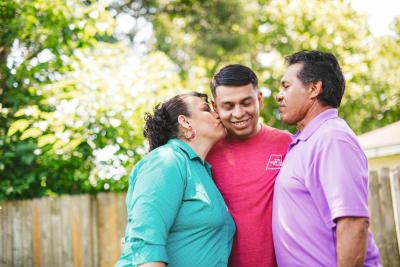
Imagine learning that a dear loved one is experiencing or is progressing into kidney failure. To live, they’ll need dialysis treatments multiple times a week or a kidney transplant.
They may ask, “Would you consider donating a kidney to me?”
Currently, there are more than 98,000 people waiting for a kidney on the national transplant waitlist.[1] There are even more people who are awaiting evaluation for eligibility. With the number of people seeking transplantation, the average wait time through deceased donation can be three to five years, prolonging how long an individual will need dialysis treatments to sustain life.
Living donation is one way to increase access to transplantation and can help reduce the number of people waiting. If you are considering becoming a living donor, you’ll need to be evaluated. You may want to talk with a loved one or bring a family member or friend with you to discuss this option at the transplant center or with your doctor.
This is a significant, personal and voluntary decision. While the decision is ultimately yours, you don’t have to wrestle with it alone.
Through programs like the National Kidney Foundation’s (NKF) The Big Ask: The Big Give, you can find resources that outline what the living donation process looks like—including what you can expect physically and emotionally.
While the decision is ultimately yours, you don’t have to wrestle with it alone. |
For most donors, life with one kidney is not much different from their life before donation. “What we want to help people understand is this is a special decision that will change the recipient’s life in such an influential way,” says Maggie Igl, senior manager of clinical transformations for DaVita’s national transplant team. “And it’s a gift that will likely not change the donor’s day-to-day life: a few weeks of recovery for a donor can translate into a meaningful increase in life expectancy and quality of life for a patient no longer requiring dialysis.”
“People who choose to become living donors are providing the gift of life for their recipients,” Dr. Michael O’Shea, vice president of clinical affairs and clinical lead for transplant at DaVita, says. “But it’s just as important that their health and well-being—emotional and physical—is well cared for. The good news is that transplant centers are set up to provide this thorough support as a donor pursues this opportunity.”
Common Questions from Potential Living Donors
What does the living donation process entail?
If you decide to pursue living donation, you’ll connect with a transplant center where you’ll be appointed a living donor advocate who is dedicated to you and your experience and is there to help answer questions you may have along the way.
“If you’re thinking about becoming a living donor, it’s a personal health decision. So, you need personalized health care and support,” Meghan Mantler, MSW, LCSW and Divisional Lead Social Worker for DaVita says. “It means that you, as the donor, know you have people in your corner who are specifically dedicated to your well-being.”
To help determine your eligibility as a living donor, you will undergo a medical review to determine if you’re healthy enough to donate one of your kidneys. Your own kidney health will be assessed—as well as potential contributing risk factors like your blood pressure, your blood sugar and other considerations.
You will also discuss the financial impact of living donation. Some people may think it’s expensive, but the potential recipient’s insurance is often responsible for the medical costs. However, you’ll have to consider financial implications of medication, missed work and more. It’s a good idea to learn what your employer’s leave policy is for living donation. Your living donor advocate and social worker can also find you resources, like the National Living Donor Assistance Center, which works specifically to help address financial barriers to living organ donation in order to increase accessibility to living donor transplantation. If you’re eligible for their services, they can provide reimbursement for travel expenses, lost wages and dependent expenses (including child care or adult-care during surgery recovery).
I want to donate—what’s next?If you’ve decided to become a living donor, whether it’s for someone you know or to provide this gift for someone you don’t know, the National Kidney Foundation is a great place to start. Visit their site for The Big Ask, The Big Give to find more information, to get started or to find support even after you donate. |
I decided to donate, but I’m not a match for my loved one—what now?
“Making the decision to donate your kidney is a big step, so it can feel like defeat if you’re eligible for donation but not a match for your family member or friend,” O’Shea says, “With paired exchange, though, you can still donate your kidney and help your loved one receive the gift of life.”
Through paired exchange, individuals who have a willing donor who is not a match can receive a kidney from a matched donor who similarly cannot donate to a potential recipient one based on compatibility.
So even if you’re not a match for your loved one, you can still donate your kidney and help in giving them the gift of transplant—with the added benefit of knowing your choice has a positive impact for someone else, too.
I don’t think I’m ready to donate. Is there anything else I can do instead?
It’s okay to say no to living donation—and there are other ways you can help your loved one during their journey. One thing you can do is help share their story. Searching for a living donor can be a long process, but expanding the individual’s network to include your own can help.
This can include things like sharing their story on your social media channels, bringing it up in your next book club meeting and asking to speak about their experience and need at your church or other
[1] Based on OPTN data as of January 31, 2023. https://optn.transplant.hrsa.gov/data/view-data-reports/national-data/#











